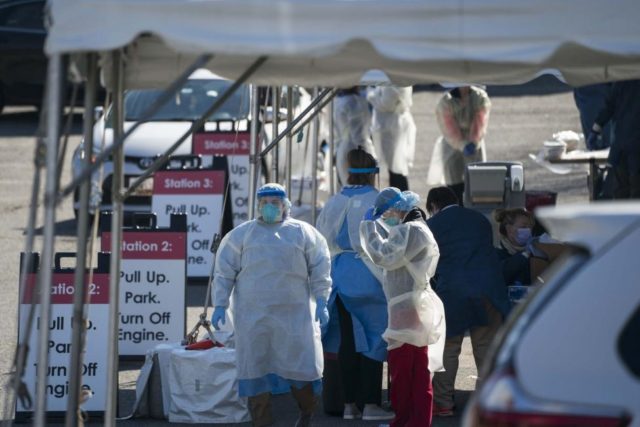The internal watchdog at the U.S. Department of Health and Human Services (HHS) conceded that there were “limitations,” including “some evidence of response bias,” in its recent survey that found shortages of novel coronavirus testing supplies and other medical gear at some U.S. hospitals.
Moreover, the office of the inspector general (OIG) at HHS said it did not independently verify the information provided by the hospitals. The HHS inspector general (IG) conducted the five-day (March 23 to 27) survey primarily through telephone interviews, but also via email.
On Monday, the HHS OIG released the results of the interviews of 323 U.S. hospitals selected at random.
The IG, which focused on hospitals’ challenges and needs in responding to the raging coronavirus pandemic, found that some of the medical centers are facing a deficit in supplies and adequate staff as well as extended waits for test results that are limiting their ability to care for patients.
Several hospitals also predicted a shortfall of medical gear, such as ventilators, and a lack of capacity if they were to face a surge in coronavirus patients.
During the White House Coronavirus Task Force press briefing on Monday, HHS Assistant Secretary for Health Adm. Brett Giroir blasted the IG survey results as outdated.
Testing numbers have dramatically improved in recent days, the admiral asserted.
Some hospitals, particularly in the epicenter of the U.S. outbreak, New York, have also begun to see a substantial drop in coronavirus hospitalizations amid the prevention measures implemented by federal, local, and state governments.
Referring to the survey in a report issued on Monday, the HHS inspector general acknowledged:
We have three limitations: 1) hospital responses reflect a point in time (March 23–27, 2020), but the pandemic is fast-moving, as are efforts to address it. Since our interviews, some hospital challenges may have worsened, and others may have improved; 2) we did not independently verify the information reported by hospital administrators. Rather, we report on hospitals’ experiences and perceptions as they were conveyed to OIG; and 3) our analysis found some evidence of response bias. Specifically, larger hospitals appear to be under-represented in the pool of respondents, and as a result, their views may be under-represented.
Slightly more than half (163) of the surveyed hospitals were reasonably small, with a bed capacity of 100 or less. About four out in ten (124) surveyed hospitals had 50 or fewer beds.
Moreover, the HHS IG was only able to confirm that 117, or about one-third, of the surveyed medical centers had patients with “confirmed” novel coronavirus illness (COVID-19). The remaining medical centers were either treating one or more patients with suspected (130) coronavirus, no virus at all (32), or did not provide any information (44).
On Monday, President Donald Trump suggested that there were political reasons behind the HHS IG releasing the report at a time when his administration’s response is beginning to yield results.
White HouseIG Christi Grimm began her career with office of the inspector general at HHS in 1999 during the former Democrat President Bill Clinton’s administration. She became the principal watchdog at HHS in January 2020.
Adm. Giroir noted that he was not informed about the problems highlighted in the IG report until he saw it in the media on Monday.
The HHS IG survey found:
Hospitals reported that their most significant challenges centered on testing and caring for patients with known or suspected COVID-19 and keeping staff safe. Hospitals also reported substantial challenges [in] maintaining or expanding their facilities’ capacity to treat patients with COVID-19. Hospitals described specific challenges, mitigation strategies, and needs for assistance related to personal protective equipment (PPE), testing, staffing, supplies and durable equipment; maintaining or expanding facility capacity; and financial concerns.
…
Hospitals across the country reported facing similar challenges, regardless of which stage of the process they were in—treating patients with coronavirus 2019 (COVID-19), testing patients who were potentially infected, or preparing to treat COVID-19 patients in the near future.
The surveyed medical centers also complained that “changing and sometimes inconsistent [coronavirus] guidance from Federal, State, and local authorities posed challenges and confused hospitals and the public,” the IG said.
“Hospitals also reported concerns that public misinformation has increased hospital workloads (e.g., patients showing up unnecessarily, hospitals needing to do public education) at a critical time,” the watchdog added.
As of Tuesday evening, the novel coronavirus had infected 395,090 people and killed 12,786, according to a New York Times database.

COMMENTS
Please let us know if you're having issues with commenting.